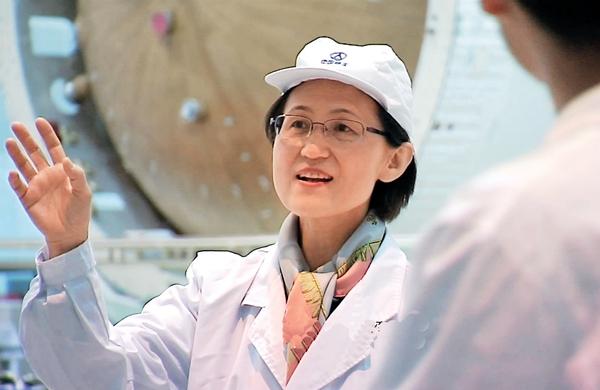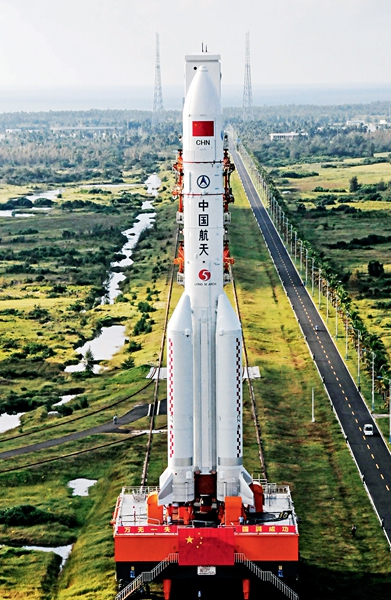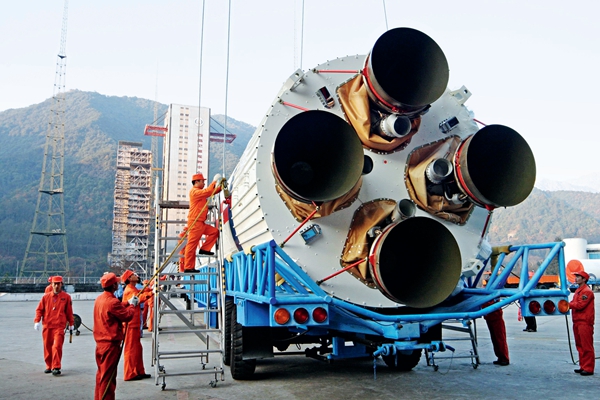By staff reporter ZHOU LIN
By staff reporter ZHOU LIN
THE Chinese orbital carrier rocket Long March 3A (Chang Zheng 3A, or CZ-3A) awaits the countdown from the Xichang Satellite Launch Center deep in the Great Liangshan Mountains of southwest China’s Si-chuan Province.

After reaching “Zero” Jiang Jie, chief designer of the mission, gives the order for CZ-3A to ignite and take off.

“Hit 10,000-mile-distant Target”
Jiang Jie is an academician at the Chinese Academy of Sciences and chief designer of the China Academy of Launch Vehicle Technology CZ-3A series of rocket launchers.
She often reflects, “Thirty years ago, discovering aerospace was my dream; but today, it is my passion!”
Jiang Jie began her career at the China Academy of Launch Vehicle Technology in 1983, after graduation from the National University of Defense Technology. Since then, she has risen through the ranks from designer, to academic research leader, to chief rocket launch designer. Throughout these three decades she has dedicated herself wholeheartedly to research on CZ-3A series rocket launchers.

A launch vehicle is the rocket on a spaceflight that carries the payload from the Earth’s surface to outer space.
The CZ-3A series rocket launchers comprises the CZ-3A, CZ-3B, and CZ-3C/YZ-1, the latter two of which are heavier versions of the CZ-3A. The launch vehicle consists of a three-stage rocket which usually carries BeiDou Navigation Satellites, communications satellites, and international commercial satellites into outer space. Having undertaken all kinds of high orbital space missions, the CZ-3A series launches account for one third of all China’s carrier rocket launch missions. The capability of the launch vehicle is a determining factor in the potential success of China’s spaceflights. “The rocket launcher is like the first baton in a relay-race. We must ensure its good performance in order to give full play to the satellites it carries,” Jiang Jie said.
When the Chang’e-3 Lunar Probe was launched as part of the Chinese Lunar Exploration Program, it directly entered the earth-moon transfer orbit at 200 km perigee and 380,000 km apogee before separating from the carrier rocket. The journey could be compared to taking an elevator directly to the target, one thus demanding unerring accuracy.
“If we compare rocket launching to archery, earlier missions needed only to hit the third ring of the target; however, this time we must hit the bull’s eye,” Jiang Jie said.
Challenges call for innovation and transcendence. Jiang Jie and her team accordingly acted on their initiative in adopting the composite guidance technology named “double laser inertial platform plus satellite navigation.”
“This technology is like giving the carrier rocket two eyes: one that ensures the rocket follows the well-designed orbit, the other that accurately calculates the best route and automatically modifies its path,” Jiang Jie explained.
On December 2, 2013, the CZ-3C/YZ-1 successfully carried the Chang’e-3 Lunar Probe to the moon.
Since the beginning of her career, Jiang Jie has participated in research on almost 30 CZ-3A series rocket launchers. She has accumulated rich experience through major technological breakthroughs, such as designing the stable control of an asymmetric rocket through two boosters, successfully carrying out the rocket flight control mission, and accurately delivering the first lunar exploration satellite into the scheduled orbit. Jiang Jie has thus matured into an aerospace expert.
Nine Successive Triumphs in 143 Days
Their low cost, strong adaptability and high reliability have earned the CZ-3A series rocket launchers the reputation of “Gold Medal Carrier Rocket.” In recent years, this series of launch vehicles entered into a new normal of high-density launching, having chalked up nine successive triumphs in 143 days.
In 2016, the CZ-3A series rocket launchers successfully completed seven missions, so becoming the most frequent task fulfillers. In 2017, they will carry out an estimated 10 launches, and during the most intensive period complete a launch every 15 days.
Rocket launching is a high-risk task, and all technologies in this respect are China’s self-dependent innovations. Since any minor problem would put the launch mission at serious risk, priority is always given to quality research and production. Therefore, Chinese aerospace researchers have adopted a batch production process and quality control system. They have also made progress in their work on the advanced technology needed for reliable design and management, so to achieve “zero pre-launch-defaults.”
The CZ-3A series rocket launchers inspire great confidence due to being flexible as regards altitude control and adaptable to a range of launch missions. In recent years, CZ-3A rocket launchers have maintained the highest speed of any, in order to meet the market’s needs. Indeed, rocket launchers which are best adapted to consumers’ needs have proven the most popular in the domestic commercial launcher market.
“The high density launch period originates in the great demands generated by the rapid development of China’s communication, navigation, remote-sensing, meteorology satellites systems, and its multiple international commercial launch missions,” Jiang Jie said.
Taking the BeiDou Satellite Navigation System as an example, the global system network of 30-plus satellites which are to be launched by 2020 will become one of the largest constellations in the history of both China and the world’s aerospace. The new global network has three distinctive optimized orbits capable of giving full play to BeiDou’s navigation functions.
Jiang Jie further explained, different from the BeiDou District Satellite Navigation System, which covers only the Asia-Pacific region, the global system network demands more satellites to cover more areas. High density launching, therefore, is needed to guarantee the constellation’s overall service life. Meanwhile, the carrier rockets send satellites directly into the working orbit rather than the transfer orbit. This saves the several days needed for each satellite to change orbit, and also obviates any need for orbit maneuvering motors.
It is reported that CZ-3A series rocket launchers, as the main rocket in China for launching high orbital satellites, have experienced several high density launching periods. They include the 26 missions from 2010 to 2012 which helped maintain a good rate of success according to world leading standards. In recent years, the BeiDou District Satellites Navigation System Network has fulfilled its mission to launch a 14 satellite, multiple-orbit constellation. Chang’e-2 and Chang’e-3 were successfully transported into outer space, where carrier rockets directly sent the lunar probes into the earth-moon transfer orbit. This laid a foundation for China’s large-scale constellation networks and future deep space explorations.
From Big to Strong Aerospace Power
Jiang Jie recalled, “The history of CZ-3A series rocket launchers’ research and development has undergone three stages of capability formation, updating, and expansion.”
In the first phase, called the 1.0 Era, the CZ-3A could launch high orbit satellites into the geostationary transfer orbit (GTO), but satellites needed to transfer several times into the final orbit.
In the 2.0 Era, carrier rockets were able to launch synchronous orbit satellites, and also transport them into different medium- and high-orbits. The lunar probe program made the direct launch into the earth-moon transfer orbit a reality. Meanwhile, construction of the BeiDou Satellite Navigation System made possible the launch of the Medium Earth Orbit and Inclined Geosynchronous Orbit satellites.
In today’s 3.0 Era, the CZ-3A series rocket launchers have expanded from a three-stage device into a four-stage machine – the CZ-3D, whose upper stage can launch the medium- and high-orbital satellites directly into the trajectory, and also update rockets so that they can adapt to various missions.
2016 marked the 60th anniversary of China’s aerospace undertakings. During that year, 22 missions were fulfilled by Long March series launch vehicles, and 40 spacecraft were successfully delivered into outer space.
China also built its first coastal base this year, the Wenchang Satellite Launch Center, in Hainan Province, which fulfilled its inaugural space launch mission. The first Long March 5 flight was the milestone event in the history of China’s rocket launchers. It brought China’s carrying capacity on a par with that of the United States and Russia. China is now making the stride from a big to a strong power in aerospace industry.
During the 13th Five-Year Plan period, Long March series rocket launchers are expected to complete over 100 missions. As of 2020, the CZ-3A series will execute eight to 10 launches annually.
“Rocket launching is a systematic project that needs cooperation in various aspects. Consequently it presents my ability to solve problems with tremendous challenges. It requires me to focus on the system as a whole,” Jiang Jie concluded. “However, whenever high density launch missions come, we welcome them with confidence.”